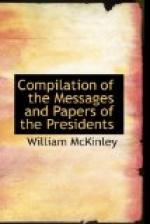I recommend that in recognition of the signal act of heroism of First Lieutenant Frank H. Newcomb, United States Revenue-Cutter Service, above set forth, the thanks of Congress be extended to him and to his officers and men of the Hudson, and that a gold medal of honor be presented to Lieutenant Newcomb, a silver medal of honor to each of his officers, and a bronze medal of honor to each member of his crew who served with him at Cardenas.
It will be remembered that Congress by appropriate action recognized the several commanders of ships of war for their services in the battle of Manila, May 1, 1898.
The commander of the revenue cutter Hugh McCulloch, present and in active cooperation with the fleet under Commodore Dewey on that occasion (by Executive order under the provisions of section 2757, Revised Statutes), is the only commander of a national ship to whom promotion or advancement was not and could not be given, because he already held the highest rank known to the Revenue-Cutter Service.
I now recommend that in recognition of the efficient and meritorious services of Captain Daniel B. Hodgsdon, United States Revenue-Cutter Service, who commanded the Hugh McCulloch at the battle of Manila (that officer being now in the sixty-third year of his age and having served continuously on active duty for thirty-seven years), he be placed upon the permanent waiting-orders or retired list of the Revenue-Cutter Service on the full-duty pay of his grade.
WILLIAM McKINLEY.
EXECUTIVE MANSION, June 27, 1898.
To the Congress of the United States:
On the morning of the 3d of June, 1898, Assistant Naval Constructor Richmond P. Hobson, United States Navy, with a volunteer crew of seven men, in charge of the partially dismantled collier Merrimac, entered the fortified harbor of Santiago, Cuba, for the purpose of sinking the collier in the narrowest portion of the channel, and thus interposing a serious obstacle to the egress of the Spanish fleet which had recently entered that harbor. This enterprise, demanding coolness, judgment, and bravery amounting to heroism, was carried into successful execution in the face of a persistent fire from the hostile fleet as well as from the fortifications on shore.
Rear-Admiral Sampson, commander in chief of our naval force in Cuban waters, in an official report dated “Off Santiago de Cuba, June 3, 1898,” and addressed to the Secretary of the Navy, referring to Mr. Hobson’s gallant exploit, says:
As stated in a recent telegram, before coming here I decided to make the harbor entrance secure against the possibility of egress of the Spanish ships by obstructing the narrow part of the entrance by sinking a collier at that point. Upon calling upon Mr. Hobson for his professional opinion as to a sure method of sinking the ship, he manifested a most lively interest in the problem. After




